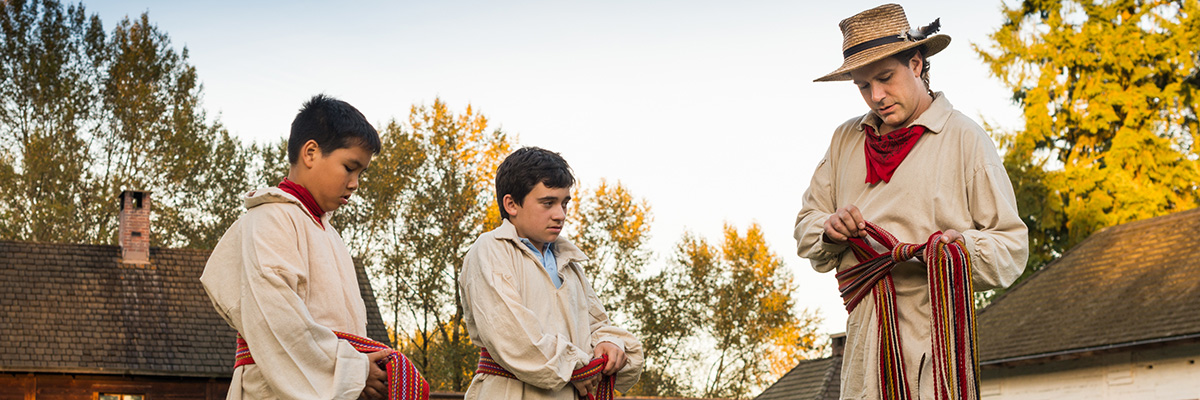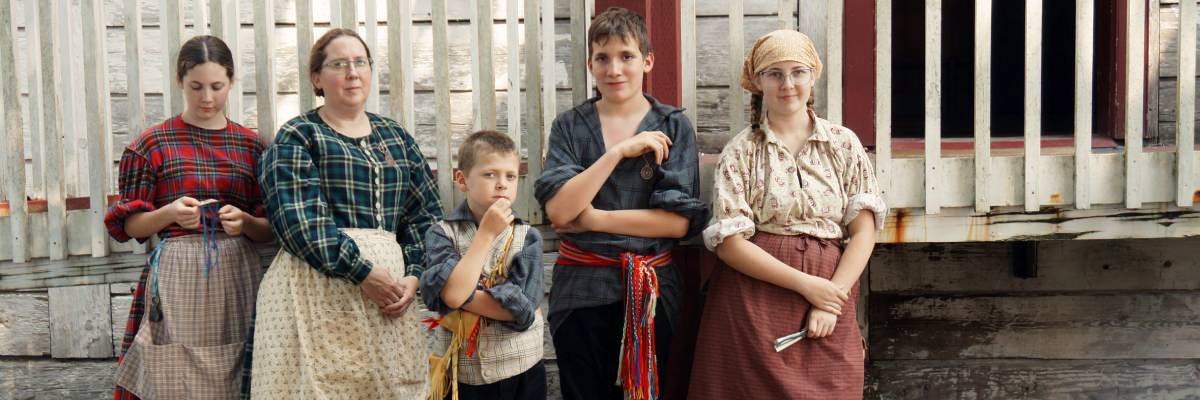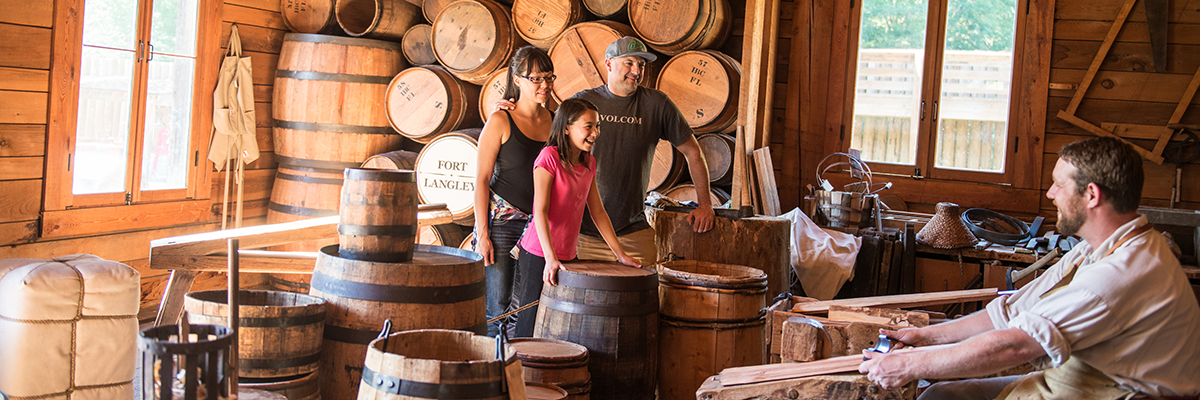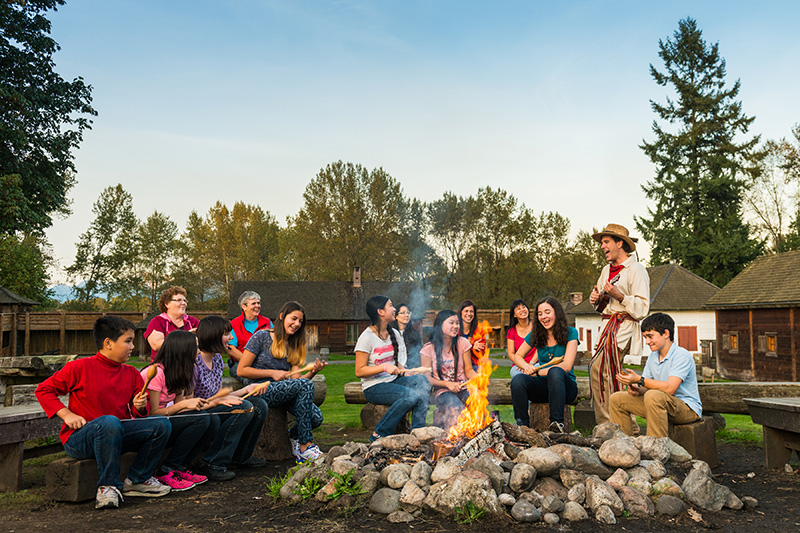
What we heard - A consultation summary for the 2024 management plan
Fort Langley National Historic Site
Introduction
A management plan, prepared in consultation with Indigenous peoples and Canadians, is the main public accountability document for heritage places administered by Parks Canada. A management plan identifies the vision and long-term strategic direction for each heritage place and describes how that vision and direction will be achieved over a ten-year timeframe. The 2024 management plan replaces the 2013 Fort Langley National Historic Site of Canada Management Plan. Parks Canada places a high priority on building effective relationships with local communities. Fort Langley National Historic Site is located on the unceded territory of the q̓ʷɑ:n̓ƛ̓ən̓ (Kwantlen), q̓ic̓əy̓ (Katzie), Máthxwi (Matsqui), and se’mya’me (Semiahmoo) First Nations.
The Hudson's Bay Company chose the current location of the site as a trading post in 1839. It was strategically located on the south bank of the Fraser River with McMillan Island located to the north of the site, directly across the Bedford Channel. The longhouses and canoes of the Kwantlen people, a major trading partner at the fort and intermediaries in the trade with other Indigenous communities, once bordered the island’s shores. McMillan Island remains the home of the Kwantlen community today.
Métis people held significant roles in all levels of work in the fur trade at Fort Langley, including labourers, freighters, craftsmen, and occasionally clerks. They especially helped to facilitate valuable relationships between First Nations and traders and settlers. The role of Métis people during the fur trade, in what would become British Columbia, was vital and also shares many of the same kinship networks and cultural keystones of other Métis communities in western Canada historically and today. Parks Canada works with Métis Nation British Columbia on a variety of programs and events of mutual interest at Fort Langley National Historic Site.
Acknowledging the impact of colonialism on Indigenous peoples is a critical part of healing and taking a step toward reconciliation. Parks Canada’s priority is to support Indigenous peoples in sharing their connection to ancestral lands and waters, their stories and experiences, and to welcome more narratives, perspectives and voices.

Engagement and consultation
Public involvement is the cornerstone of Parks Canada’s management plans and ensures that the views of, and feedback from, Indigenous peoples and Canadians help shape the future of heritage places. First Nations and Métis communities, as well as partners, interest-holders, and the public, participated in the development of the 2024 management plan.
Engagement and consultation occurred in two distinct phases. Phase 1 helped inform the development of the draft management plan, whereas Phase 2 gathered feedback on the proposed vision and key strategies to help complete the final management plan.
In summer 2023, Parks Canada invited local First Nations and Métis communities, as well as various partners, interest-holders, and the public, to participate in Phase 1 consultation. Invitees provided preliminary feedback through meetings, on-site engagement sessions, and an online survey to inform the development of a draft management plan. Parks Canada completed an initial What We Heard report in 2023.
Phase 2 consultation began in spring 2024. The draft management plan was available online and was shared with local First Nations and Métis Nation British Columbia. In addition to in-person and virtual engagement sessions with partners, interest-holders, and the public, most consultations took place on an online platform. Participants provided feedback on the proposed vision and key strategies to help complete the management plan and this final What We Heard report.

Who we heard from
Throughout the planning process and two consultation phases, Parks Canada primarily heard from community members, partners, interest-holders, and the public residing in Metro Vancouver and the Lower Mainland of British Columbia. q̓ʷɑ:n̓ƛ̓ən̓ (Kwantlen), Máthxwi (Matsqui), se’mya’me (Semiahmoo), and q̓ic̓əy̓ (Katzie) First Nations, Métis Nation British Columbia, and a variety of partners and interest-holders were personally invited to participate. The public were invited through social media, media relations, and other communications efforts. Parks Canada continues to work with local First Nations and Métis Nation British Columbia to build upon shared goals and mutually beneficial relationships.
Phase 1 and 2 engagement and consultation activities
During Phase 1, on-site and virtual engagement and consultation sessions hosted participants representing organisations that serve Black people, Indigenous people, people of colour, people with autism, people with disabilities, and people from various cultures, ethnic origins, and speakers of different languages. Kwantlen community members and representatives from local businesses also participated.
During Phase 1 consultation, a total of 21 representatives from the following Indigenous, partner, and interest-holder groups participated in a total of six virtual meetings and on-site engagement sessions:
- Métis Nation British Columbia
- Metro Vancouver Regional Parks
- Canucks Autism Network
- Spinal Cord Injury BC
- Rick Hansen Foundation
- Chew On This Tasty Tours
- BC Centre for Ability
- City of Richmond
- Colour the Trails
- Hālau Hula Ka’Uhane O Ka Pakipika / Spirit of the Pacific Cultural Society
- Fort Langley Legacy Foundation
Parks Canada developed an online platform to collect feedback during both phases of the management planning process. The first online survey was open from August 5 to September 30, 2023, and received 151 responses. Most responses came from the Metro Vancouver region, with a moderate response from across British Columbia and the rest of Canada.
Phase 2 consultation on the draft management plan began in spring 2024. Most feedback was provided through the online platform. A survey was used for participants to rate the draft management plan and provide feedback on the proposed vision and key strategies. The online survey was open from June 23 to July 24, 2024, and received 114 responses. Most responses came from the Metro Vancouver and Lower Mainland regions, including Langley, Surrey, Abbotsford, Vancouver, Burnaby, Maple Ridge, Port Moody, and Richmond.
In addition, partners, interest-holders, and the public participated in three in-person and virtual consultation sessions and a total of 15 individuals provided feedback. Feedback from participants helped complete the management plan and this final What We Heard report.

What we heard
All feedback was carefully reviewed and considered to finalise the 2024 Fort Langley National Historic Site Management Plan. Many thanks to all who participated. The feedback will help shape the management of Fort Langley National Historic Site.
All suggestions and concerns were carefully reviewed and considered. Some comments have directly influenced the management plan, and others have been flagged for further consideration during the implementation of the plan, or the preparation of associated plans and strategies over the next ten years.
Participants in the first phase of consultation provided a wide range of feedback. The following themes emerged:
- The importance of Indigenous people sharing their own stories.
- Visitors learning about Indigenous peoples’ connections to Fort Langley National Historic Site.
- The importance of sharing a diversity of perspectives and allowing people to share their stories in their own voices.
- Visitors learning about the impacts of colonialism.
- Maintaining or improving the historic character of the site.
- Maintaining or improving the condition of the site’s built assets.
- Improving access and connection to the Fraser River and the riverfront property.
Responses helped identify priority issues and gaps to inform the proposed vision and key considerations for the draft management plan.
Refining the vision
During Phase 2, respondents commented on the length and the lack of clarity in the proposed vision. Based on the overall feedback, Parks Canada refined the vision to be more concise and clearly articulate the desired future state of Fort Langley National Historic Site.
Feedback on the key strategies and objectives
Each key strategy contains objectives and targets to guide site management and decision-making over the next ten years. The objectives describe desired outcomes. The targets outline when that desired outcome has been reached following implementation of program activities. During Phase 2, participants were asked how much they agreed with, or disagreed with, the intent of each key strategy. Participants were also asked to rate the level of importance of each key strategy to them. The results of the feedback are outlined below. All feedback was carefully reviewed and considered to finalise the management plan.
Key Strategy 1: Building relationships
This proposed key strategy and corresponding objectives focused on the importance of collaboration, community connections, and relationships that support the success of Fort Langley National Historic Site.
Respondents were asked to rate how important the proposed Key Strategy 1: Building relationships was to them. Most respondents selected “important” (75%) and a significant number selected “somewhat important” (22%). A smaller number of respondents selected “not very important” (2%) or “not important” (2%).

Respondents were also asked how much they agreed with the elements of the first key strategy. Most respondents selected “agree” (73%) and a significant number selected the “somewhat agree” (21%). A small number selected the “somewhat disagree” (3%) or “disagree” (3%).

Response to feedback
We revised the first key strategy to emphasise the importance of the range of collaborations and relationships that support the success and stewardship of Fort Langley National Historic Site. Building relationships with diverse community groups, both Indigenous and non-Indigenous, is important to Parks Canada and this was clarified. This strategy was also edited to include a reference to the Calls to Action of the Truth and Reconciliation Commission. The objective that references Métis communities was clarified based on feedback from Métis Nation British Columbia.
Key Strategy 2: Building experiences
This proposed key strategy and corresponding objectives focused on connecting visitors to the natural and cultural heritage at Fort Langley National Historic Site through high-quality visitor experiences and outreach initiatives. Respondents were asked to rate how important the proposed Key Strategy 2: Building experiences was to them. Most respondents selected “important” (71%) and a significant number selected “somewhat important” (25%). A smaller number selected “not very important” (4%) and none selected “not important”.

Respondents were asked to rate their level of agreement with the second key strategy. Most respondents selected “agree” (60%) and a significant number selected “somewhat agree” (32%). Of note, some respondents selected “somewhat disagree” (7%) or the “disagree” option (2%).

Response to feedback
An important aspect of continuing to acknowledge the impact of colonialism on Indigenous people, Black people, and people of colour, includes helping visitors develop a deeper understanding of their historical presence at the site and the relevance of different or changing perspectives today. This important and challenging work will involve strengthening relationships with First Nations and Métis communities, and other diverse communities, and inviting them to share their stories in their own voices.
We made minor changes to the second key strategy to confirm Parks Canada’s approach to improving visitor experiences and outreach initiatives, which aligns with the clarifications made to the vision for the site. Parks Canada recognises the need to collaborate with cultural heritage groups and diverse communities, in addition to First Nations and Métis communities, especially with respect to how their stories and any associated objects or displays will be presented. The aim is to help broaden perspectives about Canada’s history. This includes working with community members and groups to create dedicated spaces that are either engaging and interactive, or are quiet spaces to reflect on important discussions or presentations.
As part of Parks Canada’s outreach efforts, work at the site extends to virtual learning opportunities and accessible exhibits to ensure visitors and the public are engaged in a variety of ways. Parks Canada has clarified the measurements and targets associated with the objective aimed at increasing visitation to Fort Langley National Historic Site in a sustainable manner. Promotion and outreach efforts were also clarified.
Parks Canada will monitor and respond to, as appropriate, the impact of increased density in the community. This includes continuing to assess relevant development projects that are on or adjacent to the site and monitoring on-site parking availability for visitors. We edited the wording about addressing the ongoing parking pressures at the site and transitioning to a paid parking model for non-visitors. This is related to the increases in population density in the region, as well as other transportation challenges.
Key Strategy 3: Conserving for future generations
This proposed key strategy and corresponding objectives focused on conserving the built assets, cultural resources, and natural resources at Fort Langley National Historic Site.
Respondents were asked to rate how important proposed Key Strategy 3: Conserving for future generations was to them. Most respondents selected “important” (87%) and the remaining respondents selected “somewhat important” (13%). Neither the “not very important” nor the “not important” options were selected.

Most respondents selected “agree” (85%) regarding the elements of the third key strategy, whereas 11% selected “somewhat agree”, 4% selected “somewhat disagree”, and none selected “disagree”.

Response to feedback
We made minor adjustments to the third key strategy. Parks Canada clarified the wording regarding the priorities for conserving the built assets, cultural resources, and natural resources, and the long-term sustainability of the site’s cultural heritage assets as core elements of site operations. Investments in visitor infrastructure will focus on improving accessibility.
Parks Canada will continue to assess the artefacts and belongings in the Native Sons collections, as capacity permits.
Parks Canada will collaborate with partners and interest-holders on efforts to better understand how to address the impacts of climate change, and to determine the feasibility of establishing a more tangible connection to the riverfront property.

Contact us
Fort Langley National Historic Site
23433 Mavis Avenue
Fort Langley, British Columbia
Related links
- Date modified :
